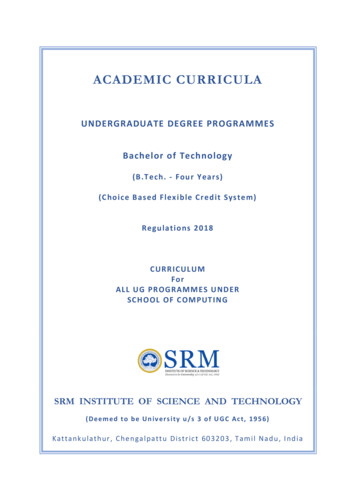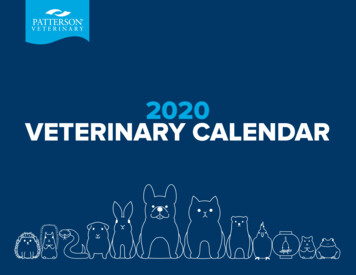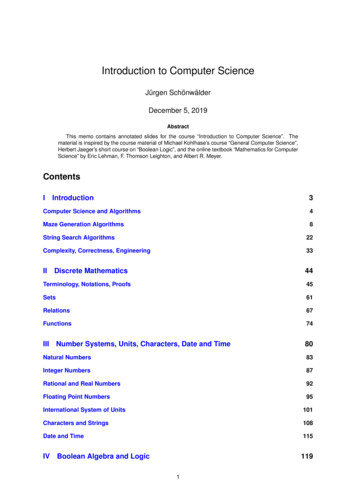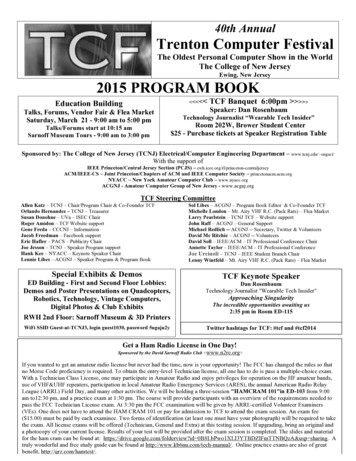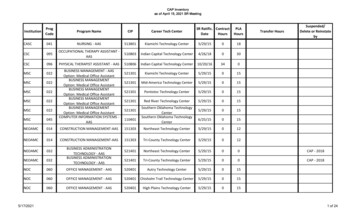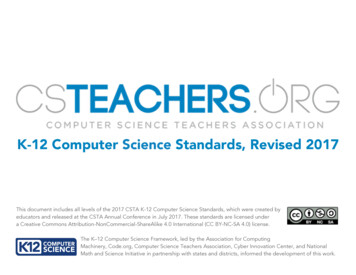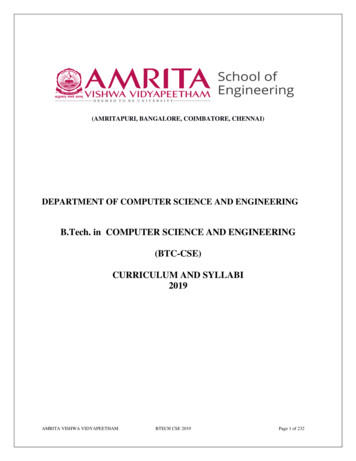
Transcription
(AMRITAPURI, BANGALORE, COIMBATORE, CHENNAI)DEPARTMENT OF COMPUTER SCIENCE AND ENGINEERINGB.Tech. in COMPUTER SCIENCE AND ENGINEERING(BTC-CSE)CURRICULUM AND SYLLABI2019AMRITA VISHWA VIDYAPEETHAMBTECH CSE 2019Page 1 of 232
GENERAL INFORMATIONABBREVIATIONS USED IN THE orialPracticalCreditsEngineering Sciences (including General, Core and Electives)Humanities (including Languages and others)Basic Sciences (including Mathematics)Project Work (including MMATMEEPHY-Aerospace EngineeringComputer Science and Engineering - Artificial IntelligenceBiologyComputer and Communication EngineeringChemical EngineeringChemistryComputer Science and EngineeringCivil EngineeringCultural EducationElectronics and Computer EngineeringElectronics and Communication EngineeringElectrical and Electronics EngineeringElectrical and Computer EngineeringHumanitiesMathematicsMechanical EngineeringPhysicsCourse Outcome (CO) – Statements that describe what students are expected to know, and are able to do at the endof each course. These relate to the skills, knowledge and behaviour that students acquire in their progress through thecourse.Program Outcomes (POs) – Program Outcomes are statements that describe what students are expected to know andbe able to do upon graduating from the Program. These relate to the skills, knowledge, attitude and behaviour thatstudents acquire through the program. NBA has defined the Program Outcomes for each discipline.PROGRAM OUTCOMES FOR ENGINEERING1.2.3.4.Engineering knowledge: Apply the knowledge of mathematics, science, engineering fundamentals, and anengineering specialization to the solution of complex engineering problems.Problem analysis: Identify, formulate, review research literature, and analyze complex engineering problemsreaching substantiated conclusions using first principles of mathematics, natural sciences, and engineeringsciences.Design/development of solutions: Design solutions for complex engineering problems and design systemcomponents or processes that meet the specified needs with appropriate consideration for the public health andsafety, and the cultural, societal, and environmental considerations.Conduct investigations of complex problems: Use research-based knowledge and research methods includingdesign of experiments, analysis and interpretation of data, and synthesis of the information to provide validconclusions.AMRITA VISHWA VIDYAPEETHAMBTECH CSE 2019Page 2 of 232
5.Modern tool usage: Create, select, and apply appropriate techniques, resources, and modern engineering and ITtools including prediction and modeling to complex engineering activities with an understanding of thelimitations.6. The engineer and society: Apply reasoning informed by the contextual knowledge to assess societal, health,safety, legal and cultural issues and the consequent responsibilities relevant to the professional engineeringpractice.7. Environment and sustainability: Understand the impact of the professional engineering solutions in societaland environmental contexts, and demonstrate the knowledge of, and need for sustainable development.8. Ethics: Apply ethical principles and commit to professional ethics and responsibilities and norms of theengineering practice.9. Individual and team work: Function effectively as an individual, and as a member or leader in diverse teams,and in multidisciplinary settings.10. Communication: Communicate effectively on complex engineering activities with the engineering communityand with society at large, such as, being able to comprehend and write effective reports and design documentation,make effective presentations, and give and receive clear instructions.11. Project management and finance: Demonstrate knowledge and understanding of the engineering andmanagement principles and apply these to one’s own work, as a member and leader in a team, to manage projectsand in multidisciplinary environments.12. Life-long learning: Recognize the need for, and have the preparation and ability to engage in independent andlife-long learning in the broadest context of technological change.AMRITA VISHWA VIDYAPEETHAMBTECH CSE 2019Page 3 of 232
SEMESTER ICat.CodeTitleLTPCreditHUM19ENG111Technical Communication2033SCI19MAT101Single Variable Calculus1001SCI19MAT111Multivariable Calculus2002SCI19MAT102Matrix Algebra2002ENGG19CSE100Problem Solving and Algorithmic Thinking2134ENGG19MEE100Engineering Graphics - CAD2033ENGG19CSE101Computer Systems Essentials3034ENGG19CSE180Computer Hardware Essentials0031HUM19CUL101Cultural Education - I2002TOTAL3222SEMESTER IICat.CodeTitleLTPCreditSCI19MAT115Discrete Mathematics3104SCI19MAT112Linear Algebra2103SCI19PHY101Engineering Physics - A2103ENGG19CSE102Computer Programming3034ENGG19EEE111Electrical and Electronics Engineering3003ENGG19EEE182Electrical and Electronics Engg Practice0031ENGG19CSE103User Interface Design1032ENGG19CSE111Fundamentals of Data Structures2002ENGG19MEE181Manufacturing Practice0031HUM19CUL111Cultural Education - II2002TOTAL3325AMRITA VISHWA VIDYAPEETHAMBTECH CSE 2019Page 4 of 232
SEMESTER IIICat.CodeTitleLTPCreditSCI19MAT201Numerical Methods1001SCI19MAT202Optimization Techniques2002ENGG19ECE204Digital Electronics and Systems3104ENGG19CSE201Advanced Programming2033ENGG19CSE205Program Reasoning2033ENGG19CSE202Database Management System3034ENGG19CSE204Object Oriented Paradigm2033ENGG19ECE282Digital Electronics and Systems Lab0031HUM19AVP201Amrita Value Programme1001Total3222SEMESTER IVCat.CodeTitleLTPCreditSCI19MAT205Probability and Random Processes3104ENGG19CSE212Data Structures and Algorithms3034ENGG19CSE214Theory of Computation3003ENGG19CSE211Computer Organization and Architecture3034ENGG19CSE213Operating Systems3034HUM19AVP211Amrita Value Programme1001Free Elective I**20021032HUMHUM19SSK211Soft Skills IHUM19MNG300Disaster ManagementTotalAMRITA VISHWA VIDYAPEETHAMBTECH CSE 2019P/F3224Page 5 of 232
SEMESTER VCat.CodeTitleLTPCreditENGG19CSE305Machine Learning3034ENGG19CSE302Design and Analysis of Algorithms3034ENGG19CSE301Computer Networks3034ENGG19CSE304Foundations of Data Science2033ENGG19CSE303Embedded Systems3034Professional Elective I*30031032ENGGHUM19SSK301Soft Skills IIENGG19LIV390Live-in –Labs***[3]HUM19ENV300Environmental ScienceP/FTotal3624 [3]SEMESTER VISemester VICat.CodeTitleLTPCreditENGG19CSE314Software Engineering2033ENGG19CSE313Principles of Programming Languages2033ENGG19CSE312Distributed Systems3034ENGG19CSE311Computer Security3003ENGGProfessional Elective II*3003ENGGProfessional Elective III*30031032HUM19SSK311Soft Skills IIIENGG19LIV490Live-in –Labs***TotalAMRITA VISHWA VIDYAPEETHAMBTECH CSE 2019[3]2921 [3]Page 6 of 232
SEMESTER VIICat.CodeTitleLTPCreditENGG19CSE401Compiler Design2033ENGGProfessional Elective IV*3003ENGGProfessional Elective V*3003ENGGProfessional Elective VI*3003ENGGFree Elective II**30030062PRJ19CSE495/19CSE491Project - Phase – 1 / SeminarHUM19LAW300Indian ConstitutionTotalP/F2317SEMESTER VIIICat.CodeTitleLTPCreditPRJ19CSE499Project - Phase – 20 0 3010Total3010Total Credit165*Professional Elective - Electives categorised under Engineering, Science, Mathematics, Live-in-Labs,and NPTEL Courses. Student can opt for such electives across departments/campuses. Students withCGPA of 7.0 and above can opt for a maximum of 2 NPTEL courses with the credits not exceeding 8.** Free Electives - This will include courses offered by Faculty of Humanities and Social Sciences/Faculty Arts, Commerce and Media / Faculty of Management/Amrita Darshanam -(InternationalCentre for Spiritual Studies).*** Live-in-Labs - Students undertaking and registering for a Live-in-Labs project, can be exemptedfrom registering for an Elective course in the higher semester.PROFESSIONAL ELECTIVESAMRITA VISHWA VIDYAPEETHAMBTECH CSE 2019Page 7 of 232
Electives in Cyber aphy3003ENGG19CSE332Information Security3003ENGG19CSE333Secure Coding3003ENGG19CSE334Cyber Forensics and Malware3003ENGG19CSE335Ethical Hacking3003ENGG19CSE336Digital Currency Programming3003ENGG19CSE337Social Networking and Security3003ENGG19CSE338Mobile and Wireless Security3003Electives in Computer NetworksCat.CodeTitleLTPCreditENGG19CSE339Wireless Sensor Networks3003ENGG19CSE340Advanced Computer Networks3003ENGG19CSE341Mobile Adhoc Networks3003ENGG19CSE342Wireless and Mobile Communications3003Electives in Data ScienceENGG19CSE351Computational statistics and InferenceTheory3003ENGG19CSE352Business Analytics3003ENGG19CSE353Mining of Massive Datasets3003ENGG19CSE354Web Mining3003ENGG19CSE355Time Series Analysis and Forecasting2033ENGG19CSE356Social Network Analytics3003ENGG19CSE357Big Data Analytics2033Electives in Computer VisionAMRITA VISHWA VIDYAPEETHAMBTECH CSE 2019Page 8 of 232
ENGG19CSE431Digital Image Processing2033ENGG19CSE432Pattern Recognition3003ENGG19CSE433Computer Graphics and Visualization2033ENGG19CSE434Image and Video Analysis2033ENGG19CSE435Computer Vision3003ENGG19CSE436Machine Vision3003ENGG19CSE437Deep Learning for Computer Vision2033ENGG19CSE438Medical Image Processing2033ENGG19CSE439Augmented and Virtual Reality3003ENGG19CSE440Biometrics3003Electives in Cyber Physical SystemsENGG19CSE441Introduction to Cyber-Physical Systems3003ENGG19CSE442Pervasive and Ubiquitous Systems3003ENGG19CSE443Spatiotemporal data management3003ENGG19CSE444Real-Time Systems3003ENGG19CSE445Cloud Computing2033ENGG19CSE446Internet of Things2033Electives in Artificial IntelligenceENGG19CSE451Principles of Artificial Intelligence2033ENGG19CSE452Semantic Web2033ENGG19CSE453Natural Language Processing2033ENGG19CSE454Information Retrieval2033ENGG19CSE455Artificial Intelligence and Robotics2033ENGG19CSE456Neural Networks and Deep Learning2033ENGG19CSE457Bayesian Machine Learning2033ENGG19CSE458Computational Intelligence2033Electives GeneralAMRITA VISHWA VIDYAPEETHAMBTECH CSE 2019Page 9 of 232
ENGG19CSE459Advanced Algorithms and Analysis3003ENGG19CSE460User Experience Design2033ENGG19CSE461Net-Centric Programming2033ENGG19CSE462Introduction to Game Theory3003Professional Electives for Other BranchesENGG19CSE471Principles of Operating Systems3003ENGG19CSE463Mobile Application Development2033ENGG19CSE464Fundamentals of Software Engineering2033ENGG19CSE465Introduction to Big Data Analytics2033ENGG19CSE466Foundation of Information Technology2033ENGG19CSE467Principles of Database Management Systems2033ENGG19CSE477Principles of Computer Networks3003ENGG19CSE204Object Oriented Paradigm2033ENGG19CSE201Advanced Programming2033ENGG19CSE282Python Programming0031PROFESSIONAL ELECTIVES UNDER SCIENCE mputational Chemistry and Molecular Modelling3003SCI19CHY236Electrochemical Energy Systems and Processes3003SCI19CHY240Fuels and Combustion3003SCI19CHY232Green Chemistry and Technology3003SCI19CHY239Instrumental Methods of Analysis3003SCI19CHY241Batteries and Fuel Cells3003AMRITA VISHWA VIDYAPEETHAMBTECH CSE 2019Page 10 of 232
SCI19CHY242Corrosion Science3003PHYSICSSCI19PHY340Advanced Classical Dynamics3003SCI19PHY342Electrical Engineering Materials3003SCI19PHY331Physics of Lasers and Applications3003SCI19PHY341Concepts of Nanophysics and Nanotechnology3003SCI19PHY343Physics of Semiconductor CI19MAT341Statistical Inference3003SCI19MAT342Introduction to Game Theory3003SCI19MAT343Numerical Methods and Optimization3003FREE ELECTIVESFREE ELECTIVES OFFERED UNDER MANAGEMENT STREAMCat.CodeTitleLTPCreditHUM19MNG331Financial Management3003HUM19MNG332Supply Chain Management3003HUM19MNG333Marketing Management3003HUM19MNG334Project Management3003HUM19MNG335Enterprise Management3003HUM19MNG338Operations Research3003HUM19MEE401Industrial Engineering3003HUM19MEE346Managerial Statistics3003AMRITA VISHWA VIDYAPEETHAMBTECH CSE 2019Page 11 of 232
HUM19MEE347Total Quality Management3003HUM19MEE342Lean Manufacturing3003HUM19CSE358Software Project Management3003HUM19CSE359Financial Engineering3003HUM19CSE360Engineering Economic Analysis3003HUM19MNG331Financial Management3003HUM19CSE362Information Systems3003FREE ELECTIVES OFFERED UNDER HUMANITIES / SOCIAL SCIENCE STREAMSCat.CodeTitleLTPCreditHUM19CUL230Achieving Excellence in Life - An Indian Perspective2002HUM19CUL231Excellence in Daily Life2002HUM19CUL232Exploring Science and Technology in Ancient India2002HUM19CUL233Yoga Psychology2002HUM19ENG230Business Communication1032HUM19ENG231Indian Thought through English2002HUM19ENG232Insights into Life through English Literature2002HUM19ENG233Technical Communication2002HUM19ENG234Indian Short Stories in English2002HUM19FRE230Proficiency in French Language (Lower)2002HUM19FRE231Proficiency in French Language (Higher)2002HUM19GER230German for Beginners I2002AMRITA VISHWA VIDYAPEETHAMBTECH CSE 2019Page 12 of 232
HUM19GER231German for Beginners II2002HUM19GER232Proficiency in German Language (Lower)2002HUM19GER233Proficiency in German Language (Higher)2002HUM19HIN101Hindi I2002HUM19HIN111Hindi II2002HUM19HUM230Emotional Intelligence2002HUM19HUM231 Glimpses into the Indian Mind - the Growth of Modern India2002HUM19HUM232Glimpses of Eternal India2002HUM19HUM233Glimpses of Indian Economy and Polity2002HUM19HUM234Health and Lifestyle2002HUM19HUM235Indian Classics for the Twenty-first Century2002HUM19HUM236Introduction to India Studies2002HUM19HUM237Introduction to Sanskrit Language and Literature2002HUM19HUM238National Service Scheme2002HUM19HUM239Psychology for Effective Living2002HUM19HUM240Psychology for Engineers2002HUM19HUM241Science and Society - An Indian Perspective2002HUM19HUM242The Message of Bhagwad Gita2002HUM19HUM243The Message of the Upanishads2002HUM19HUM244Understanding Science of Food and Nutrition2002HUM19JAP230Proficiency in Japanese Language (Lower)2002HUM19JAP2313Proficiency in Japanese Language (Higher)2002HUM19KAN101Kannada I2002HUM19KAN111Kannada II2002HUM19MAL101Malayalam I2002HUM19MAL111Malayalam II2002AMRITA VISHWA VIDYAPEETHAMBTECH CSE 2019Page 13 of 232
HUM19SAN101Sanskrit I2002HUM19SAN111Sanskrit II2002HUM19SWK230Corporate Social Responsibility2002HUM19SWK231Workplace Mental Health2002HUM19TAM101Tamil I2002HUM19TAM111Tamil II2002AMRITA VISHWA VIDYAPEETHAMBTECH CSE 2019Page 14 of 232
SYLLABUSSEMESTER I19ENG111TECHNICAL COMMUNICATIONL-T-P-C: 2-0-3-3Course ObjectivesTo introduce the students to the fundamentals of mechanics of writingTo facilitate them with the style of documentation and specific formal written communicationTo initiate in them the art of critical thinking and analysisTo help them develop techniques of scanning for specific information, comprehension and organization of ideasTo enhance their technical presentation skillsCourse OutcomeCO1: To gain knowledge about the mechanics of writing and the elements of formal correspondence.CO2: To understand and summarise technical documents.CO3: To apply the basic elements of language in formal correspondence.CO4: To interpret and analyze information and to organize ideas in a logical and coherent manner.CO5: To compose project reports/ documents, revise them for language accuracy and make technicalPresentations.CO-PO MappingPO/PSOPO1 PO2 PO3 PO4 PO5 PO6 PO7 PO8 PO9 PO10 PO11 PO12 PSO1 PSO2COCO1CO2312CO3CO4312CO521SyllabusUnit 1Mechanics of Writing: Grammar rules -articles, tenses, auxiliary verbs (primary & modal) prepositions, subject-verbagreement, pronoun-antecedent agreement, discourse markers and sentence linkersGeneral Reading and Listening comprehension - rearrangement & organization of sentencesUnit 2Different kinds of written documents: Definitions- descriptions- instructions-recommendations- user manuals - reports– proposalsFormal Correspondence: Writing formal LettersMechanics of Writing: impersonal passive & punctuationScientific Reading & Listening ComprehensionAMRITA VISHWA VIDYAPEETHAMBTECH CSE 2019Page 15 of 232
Unit 3Technical paper writing: documentation style - document editing – proof reading - Organising and formattingMechanics of Writing: Modifiers, phrasal verbs, tone and style, graphical representationReading and listening comprehension of technical documentsMini Technical project (10 -12 pages)Technical presentationsReference(s)Hirsh, Herbert. L “Essential Communication Strategies for Scientists, Engineers and Technology Professionals”. IIEdition. New York: IEEE press, 2002Anderson, Paul. V. “Technical Communication: A Reader-Centred Approach”. V Edition. Harcourt Brace CollegePublication, 2003Strunk, William Jr. and White. EB. “The Elements of Style” New York. Alliyan& Bacon, 1999.Riordan, G. Daniel and Pauley E. Steven. “Technical Report Writing Today” VIII Edition (Indian Adaptation). NewDelhi: Biztantra, 2004.Michael Swan. ‘’ Practical English Usage’’, Oxford University Press, 2000Evaluation PatternAssessmentInternal ExternalPeriodical 120Periodical 220Continuous40Assessment (Lab)(CAL)End Semester20*CA – Can be Quizzes, Assignment, Projects, and Reports.AMRITA VISHWA VIDYAPEETHAMBTECH CSE 2019Page 16 of 232
19MAT101SINGLE VARIABLE CALCULUSL-T-P-C:1-0-1-1Course Objectives Understand the various functions and their graphs.Understand the basic concept of continuous function and find the extreme values of the continuousfunctions.Understand the definite integral and various integration techniques.Course OutcomesCO1: To understand the concepts of single variable calculus.CO2: To sketch graphs for functions using the concepts of single variable calculus and apply thefundamental theorem of calculus to evaluate integrals.CO-PO MappingPO/PSOPO1 PO2 PO3 PO4 PO5 PO6 PO7 PO8 PO9 PO10 PO11 O212------2---------------------SyllabusUnit 1CalculusGraphs: Functions and their Graphs. Shifting and Scaling of Graphs. (1.5)Unit 2Limit and Continuity: Limit (One Sided and Two Sided) of Functions. Continuous Functions, Discontinuities,Monotonic Functions, Infinite Limits and Limit at Infinity. (2.1, 2.6)Unit 3Graphing : Extreme Values of Functions, Concavity and Curve Sketching, (4.1, 4.4).Unit 4Integration: Definite Integrals, The Mean Value Theorem for definite integrals, Fundamental Theorem of Calculus,Integration Techniques. (5.2 - 5.3, 8.1 – 8.5)Text BookCalculus’, G.B. Thomas Pearson Education, 2009, Eleventh Edition.Reference‘Calculus’, Monty J. Strauss, Gerald J. Bradley and Karl J. Smith, 3rd Edition, 2002Evaluation patternAt the end of the course, a two-hour test will be conducted for 50 marks. The marks will be converted to 100 forgrading.AMRITA VISHWA VIDYAPEETHAMBTECH CSE 2019Page 17 of 232
19MAT111MULTIVARIABLE CALCULUSL-T-P-C: 2- 0-0 -2Course Objective To understand parameterisation of curves and to find arc lengths.To familiarise with calculus of multiple variables.To use important theorems in vector calculus in practical problems.Course OutcomesCO1: Select suitable parameterization of curves and to find their arc lengthsCO2: Find partial derivatives of multivariable functions and to use the Jacobian in practical problems.CO3: Apply Fundamental Theorem of Line Integrals, Green’s Theorem, Stokes’ Theorem, of DivergenceTheorem to Evaluate integrals.CO-PO --------------------CO322CO3SyllabusUnit 1Functions of severable variablesFunctions, limit and continuity. Partial differentiations, total derivatives, differentiation of implicit functions andtransformation of coordinates by Jacobian. Taylor’s series for two variables.Unit 2Vector DifferentiationVector and Scalar Functions, Derivatives, Curves, Tangents, Arc Length, Curves in Mechanics, Velocity andAcceleration, Gradient of a Scalar Field, Directional Derivative, Divergence of a Vector Field, Curl of a Vector Field.Unit 3Vector IntegrationLine Integral, Line Integrals Independent of Path.Green’s Theorem in the Plane, Surfaces for Surface Integrals, Surface Integrals, Triple Integrals – Gauss DivergenceTheorem, Stoke’s Theorem.AMRITA VISHWA VIDYAPEETHAMBTECH CSE 2019Page 18 of 232
Unit 4Lab Practice Problems:Graph of functions of two variables, shifting and scaling of graphs. Vector products. Visualizing different surfaces.Text BookAdvanced Engineering Mathematics, E Kreyszig, John Wiley and Sons, Tenth Edition, 2018.Reference Book(s)Advanced Engineering Mathematics by Dennis G. Zill and Michael R.Cullen, second edition, CBS Publishers, 2012.‘Engineering Mathematics’, Srimanta Pal and Subhodh C Bhunia, John Wiley and Sons, 2012, Ninth Edition.‘Calculus’, G.B. Thomas Pearson Education, 2009, Eleventh Edition.Evaluation PatternAssessmentClass Test/Assignment/TutorialEnd of course Test (2hrs)AMRITA VISHWA VIDYAPEETHAMWeightage3070BTECH CSE 2019Page 19 of 232
19MAT102MATRIX ALGEBRAL-T-P-C: 2- 0 -0- 2Course Objectives Understand basic concepts of eigen values and eigen vectors.Apply eigen values and eigen vectors for diagonalization and quadratic form.Apply various iterative techniques to solve the system of equations.Course OutcomesCO1: Understand the notion of eigenvalues and eigenvectors, analyse the possibility of diagonalization andhence compute a diagonal matrix, if possible.CO2: Apply the knowledge of diagonalization to transform the given quadratic form into the principal axesform and analyse the given conic section.CO3: Understand the advantages of the iterative techniques and apply it to solve the system of equations andfinding eigenvectors.CO-PO PO8PO9PO10PO11PO12CO1SyllabusUnit 1Review: System of linear Equations, linear independence.Unit 2Eigen values and Eigen vectors: Definitions and properties. Positive definite, negative definite and indefiniteUnit 3Diagonalization and Orthogonal Diagonalization. Properties of Matrices. Symmetric and Skew Symmetric Matrices,Hermitian and Skew Hermitian Matrices and Orthogonal matrices.Unit 4Numerical Computations: L U factorization, Gauss Seidal and Gauss Jacobi methods for solving system ofequations. Power Method for Eigen Values and Eigen Vectors.Text BookAdvanced Engineering Mathematics, E Kreyszig, John Wiley and Sons, Tenth Edition, 2018.Reference BooksAdvanced Engineering Mathematics by Dennis G. Zill and Michael R.Cullen, second edition, CBS Publishers, 2012.Engineering Mathematics’, Srimanta Pal and Subhodh C Bhunia, John Wiley and Sons, 2012, Ninth Edition.Evaluation PatternAssessmentClass Test/Assignment/TutorialEnd of course Test (2hrs)AMRITA VISHWA VIDYAPEETHAMWeightage3070BTECH CSE 2019Page 20 of 232
19CSE100PROBLEM SOLVING AND ALGORITHMIC THINKINGL-T-P-C: 2-1-3-4Course Objectives This course provides the foundations of computational problem solving.The course focuses on principles and methods thereby providing transferable skills to any other domain.The course also provides foundation for developing computational perspectives of one’s own discipline.Course OutcomesCO 1:CO 2:CO 3:CO 4:Apply algorithmic thinking to understand, define and solve problemsDesign and implement algorithm(s) for a given problemApply the basic programming constructs for problem solvingUnderstand an algorithm by tracing its computational states, identifying bugs and correcting themCO-PO Unit 1Problem Solving and Algorithmic Thinking Overview – problem definition, logical reasoning; Algorithm – definition,practical examples, properties, representation, algorithms vs programs.Unit 2Algorithmic thinking – Constituents of algorithms – Sequence, Selection and Repetition, input-output; Computation– expressions, logic; algorithms vs programs, Problem Understanding and Analysis – problem definition, inputoutput, variables, name binding, data organization: lists, arrays etc. algorithms to programs.Unit 3Problem solving with algorithms – Searching and Sorting, Evaluating algorithms, modularization, recursion. C forproblem solving – Introduction, structure of C programs, data types, data input, output statements, control structures.Text Book(s)Riley DD, Hunt KA. Computational Thinking for the Modern Problem Solver. CRC press; 2014 Mar 27.Reference(s)Ferragina P, Luccio F. Computational Thinking: First Algorithms, Then Code. Springer; 2018.Beecher K. Computational Thinking: A beginner's guide to Problem-solving and Programming. BCS Learning &Development Limited; 2017.Curzon P, McOwan PW. The Power of Computational Thinking: Games, Magic and Puzzles to help you become acomputational thinker. World Scientific Publishing Company; 2017.AMRITA VISHWA VIDYAPEETHAMBTECH CSE 2019Page 21 of 232
Evaluation PatternAssessmentInternalEndSemesterPeriodical 110Periodical 210*Continuous Assessment (Theory) 15(CAT)Continuous Assessment (Lab)30(CAL)End Semester35*CA – Can be Quizzes, Assignment, Projects, and Reports.AMRITA VISHWA VIDYAPEETHAMBTECH CSE 2019Page 22 of 232
19MEE100ENGINEERING GRAPHICS - CADL-T-P-C: 2-0-3-3Course Objectives Familiarize with Bureau of Indian Standards (BIS) for creating engineering drawingsTrain the students on proper dimensioning and construction of simple geometriesInculcate with the concept of developing orthographic projections and isometric views using CAD draftingpackageNote:1.2.Drawing practice to be carried out using drafting package (Auto-CAD)First angle projection to be followedCourse OutcomesCO1: Understand the engineering drawing standards and their usageCO2: Interpret engineering drawingsCO3: Construct and dimension 2-D geometries using CAD softwareCO4: Improve coherent visualization skillsCO5: Inculcate with the concept of developing orthographic projections and isometric viewsCO-PO MappingPO/PSOPO1 PO2 PO3 PO4 PO5 PO6 PO7 PO8 PO9 PO10 PO11 2SyllabusUnit 1Basic principles of engineering drawing, Standards and conventions, lettering and types of lines, Introduction todrafting software, standard tool bar/menus, navigational tools. Co-ordinate system and reference planes. Creation of2 dimensional drawing environment. Selection of drawing size and scale. Sketching of 2D simple geomentries, editingand dimensioning of 2D geomentries.Unit 2Orthographic Projections: Introduction, planes of projection, projection of points in all the four quadrants. Projectionof straight lines, Projection of Plane Surfaces, Projection of regular solids, Sectioning of solidsAMRITA VISHWA VIDYAPEETHAMBTECH CSE 2019Page 23 of 232
Unit 3Plan and elevation of simple buildings with dimensionsText BookBasantAgarwal and C M Agarwal., “Engineering Drawing”, 2e, McGraw Hill Education, 2015Reference Book(s)Bhat N.D. and Panchal V.M. , “ Engineering Drawing Plane and Solid Geometry , 42e, Charoatar Publishing House, 2010James D. Bethune, “Engineering Graphics with AutoCAD”, Pearson Education, 2014K.R. Gopalakrishna, “Engineering Drawing”, 2014, Subhas PublicationsNarayan K.L. and Kannaiah P, Engineering Drawing, SciTech Publications, 2003John K.C., “Engineering Graphics for Degree”, 1e, Prentice Hall India, 2009Evaluation PatternAssessmentInternalEndSemester*Continuous Assessment (CA)80End Semester20*CA – Can be Quizzes, Assignment, Projects, and Reports.AMRITA VISHWA VIDYAPEETHAMBTECH CSE 2019Page 24 of 232
19CSE101COMPUTER SYSTEMS ESSENTIALSL-T-P-C: 3-0-3-4Course Objectives The course gives students an overview of computer science: A foundation from which they can appreciatethe relevance and interrelationships of further courses in the field.This course provides an insight on the general structures of operating systems, database management systemsand computer networks.Course OutcomesCO1: Understand the basic components of computer systems and its functionality.CO2: Demonstrate the functions of operating system and its role as a resource manager to execute anyapplicationCO3: Understand the need for database storage and learn to retrieve using SQL.CO4: Implement the connection between operating systems, computer networks and database managementthrough a case studyCO-PO labusUnit 1Introduction to Computers, Computer Science, Computer Systems. Essential components of computer systems:Operating Systems Fundamentals, Principles of Database Systems, Basic concepts in Computer Networks. Installinga Linux virtual machine. Using package manager to install/update software. Understanding disk partitions andobtaining partition information using system tools. Obtaining essential system resource utilization and informationusing system tools and proc file system: disk utilization, memory utilization, process information, CPU utilization.Pipes and redirection. Searching the file system using find and grep with simple regular expressions. Basic processcontrol using signals: pausing and resuming process from a Linux terminal, terminating a process. Adding/removingfrom search path using PATH variable. Compressing/uncompressing using tar/gzip and zip tools. Using man pages tounderstand tool documentation.Unit 2Querying a database using simple SQL commands. Writing simple SQL queries. Creating and editing tables. Creatingindexes to improve performance. Exporting and importing data from/to database tables to/from Excel.Unit 3AMRITA VISHWA VIDYAPEETHAMBTECH CSE 2019Page 25 of 232
Obtaining essential system network information using system tools: network interfaces and their addresses, routingtable, active processes using network communication. Basic network debugging: using traceroute to discover route toa remote computer, ping to check network connectivity, nslookup for DNS lookup. Understanding basic HTTP clientand server using netcat. Using ssh and sftp.Text Book(s)Brookshear JG. Computer science: an overview. Eleventh Edition, Addison-W
DEPARTMENT OF COMPUTER SCIENCE AND ENGINEERING B.Tech. in COMPUTER SCIENCE AND ENGINEERING (BTC-CSE) CURRICULUM AND SYLLABI . HUM Free Elective I** 2 0 0 2 HUM 19SSK211 Soft Skills I 1 0 3 2 . ENGG 19CSE335 Ethical Hacking 3 0 0 3
